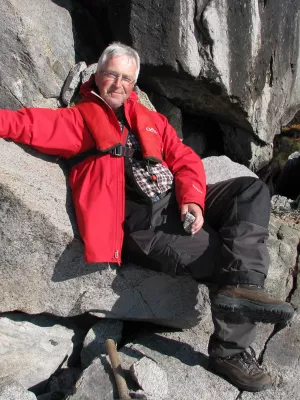
Leif Johansson
Professor emeritus

Petrogenesis of ultramafic and mafic xenoliths from Mesozoic basanites in southern Sweden: constraints from mineral chemistry
Författare
Summary, in English
Jurassic basanite necks occurring at the junction of two major fault zones in Scania contain ultramafic (peridotites, pyroxenites) and mafic xenoliths, which together indicate a diversity of upper mantle and lower crustal assemblages beneath this region. The peridotites can be subdivided into lherzolites, dunites and harzburgites. Most lherzolites are porphyroclastic, containing orthopyroxene and olivine porphyroclasts. They consist of Mg-rich silicates (Mg# = Mg/(Mg + Fe-tot) x 100; 88-94) and vermicular spinel. Calculated equilibration temperatures are lower in porphyroclastic lherzolites (975-1,007 degrees C) than in equigranular lherzolite (1,079 degrees C), indicating an origin from different parts of the upper mantle. According to the spinel composition the lherzolites represent residues of 8-13% fractional melting. They are similar in texture, mineralogy and major element composition to mantle xenoliths from Cenozoic Central European volcanic fields. Dunitic and harzburgitic peridotites are equigranular and only slightly deformed. Silicate minerals have lower to similar Mg# (83-92) as lherzolites and lack primary spinel. Resorbed patches in dunite and harzburgite xenoliths might be the remnants of metasomatic processes that changed the upper mantle composition. Pyroxenites are coarse, undeformed and have silicate minerals with partly lower Mg# than peridotites (70-91). Pyroxenitic oxides are pleonaste spinels. According to two-pyroxene thermometry pyroxenites show a large range of equilibration temperatures (919-1,280 degrees C). In contrast, mafic xenoliths, which are mostly layered gabbronorites with pyroxene- and plagioclase-rich layers, have a narrow range of equilibration temperatures (828-890 degrees C). These temperature ranges, together with geochemical evidence, indicate that pyroxenites and gabbroic xenoliths represent mafic intrusions within the Fennoscandian crust.
Avdelning/ar
- Berggrundsgeologi
Publiceringsår
2007
Språk
Engelska
Sidor
433-450
Publikation/Tidskrift/Serie
International Journal of Earth Sciences
Volym
96
Issue
3
Dokumenttyp
Artikel i tidskrift
Förlag
Springer
Ämne
- Geology
Nyckelord
- mantle xenoliths
- mantle petrogenesis
- element geochemistry
- major
- lower crust xenoliths
- Fennoscandian Shield
- layered intrusions
Status
Published
ISBN/ISSN/Övrigt
- ISSN: 1437-3254

